
This page created 23 August 2014, and last modified: 8 December 2015 (references rearranged)

The Equites Mauri alites is listed (102/5.17 in Ingo Maier's numbering scheme) as the fifth of the 32 vexillationes comitatenses in the Magister Equitum's cavalry roster; it is assigned (102/5.228) to his Gallic command. Its shield pattern (100#15) as shown in various manuscripts, under the label (100.p) Mauri alites, is as below:

The pattern has a red rim and a green main field (faded to yellow in M, W). The boss is variously white (B), yellow (M), white quartered with white (W), white quartered with blue (P), and black quartered with blue (O). The main feature is a pair of opposed zoomorphic heads with necks. At first sight, these might be taken for dracones - military standards that were introduced to the Roman forces during the 2nd century AD as a result of the Dacian wars, and which became more popular with time, to judge from e.g. Vegetius, in which a cohort is given its own standard, kept by a draconarius. Despite the name "draco" (serpent, dragon), illustrations of dracones often seem to feature a head that looks more wolf-like than serpent-like.
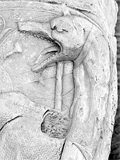
|
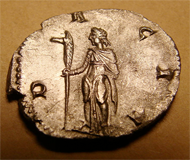
|
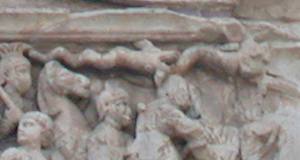
|
|
|
|
|
|
|
|
|
However, it must be said the the "dracones" borne by the Equites Mauri alites, except in the M manuscript, do not look much like these. An alternative imagery source is the twin-headed zoomorphic motif that is extremely common in the Notitia (over a dozen examples), especially amongst auxilia palatina. That borne by the Vindices (12.31), a unit of auxilia palatina under the second Magister Militum Praesentalis, is a typical example; its shield pattern as shown in various manuscripts is as below:

In addition to its numerous appearances in the Notitia, the twin-headed zoomorphic motif is known from a range of sources in northern Europe, such as on the ca. 6th century Torslunda bronze die from Sweden shown below:
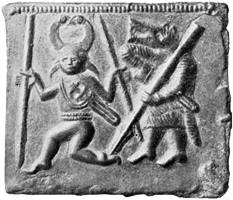
However, the version born by the Equites Mauri alites is also not like these in that the necks are disconnected. An alternative imagery source is the ostrich. The ostrich, with its notable lack of external ears coupled with extremely large eyes, looks much more like the beasts depicted in the manuscript shield patterns (except for those of M). The North African Ostrich, the largest of the ostrich subspecies, is now critically endangered, but was in Roman times a common sight, both in the wild, and at the circus. The depiction of decapitated ostriches brings to mind Herodian's description of the emperor Commodus decapitating North African ostriches in the circus by shooting at them with special crescent-headed arrows to show off his marksmanship.
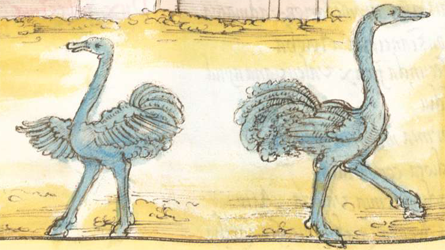
The name Mauri denotes the Moorish peoples, although there is every indication that by this date the term, as used used in the Roman military, denoted not an ethnicity but a particular kind of military unit. However, exactly what kind is hard to say: possibly a light unit, whether of foot or, as in this case, of horse, because that is how Moors fought when the Romans first encountered them. However, it is also very likely that this meaning had also been superseded with time; 600 years is a long time for a fighting style to remain unchanged, leaving the name doubly fossilized!
The the meaning of the name alites could derive from alios, meaning "the other", as in "the other unit of Equites Mauri", which would seem to be rather too prosaic for a document like the Notitia, but not impossible. It could derive from alitus, meaning to "feed, nourish, support, promote", which isn't a particularly military-sounding epithet, at least to modern ears, but do note the numerous units in the Notitia entitled felices, which, while having the meaning of "fortunate", also has an alternate meaning of "fruitful, fecund". But the name is much more likely to simply be the plural form of ales, meaning "winged, fleet, swift", and which would be a particularly good name for a unit of (light) cavalry. Note also that in Latin, the word ales means swift in a particularly aerial sense, since it is derived from ala, meaning wing (and where the military term for a unit of cavalry came from, since cavalry deployed on the "wings" of the army); the word could be used as a noun to mean a large bird. Thus the name of the Equites Mauri alites might be a triple pun: referring to the fact it was a unit of cavalry, it was particularly mobile, and it its men carried shields showing particularly large and fast birds: ostriches.
1. Ingo Maier; "Appendix 4: Numeration of the new edition of the compilation 'notitia dignitatum' (Cnd)"; last accessed 26 October 2015. See also for here for numbering examples. Return
2. Publius Flavius Renatus Vegetius ("Vegetius"); "Epitoma rei militaris", 2.13; available here in Latin and here in English (last accessed 3 December 2015). Return
3. Herodian; "Tes meta Markon basileias istoria" (History of the Empire from the Death of Marcus), 1.15.5; available here in English (last accessed 8 December 2015). Return

Return to the Notitia alphabetical unit list page.
Return to my Notitia index page.